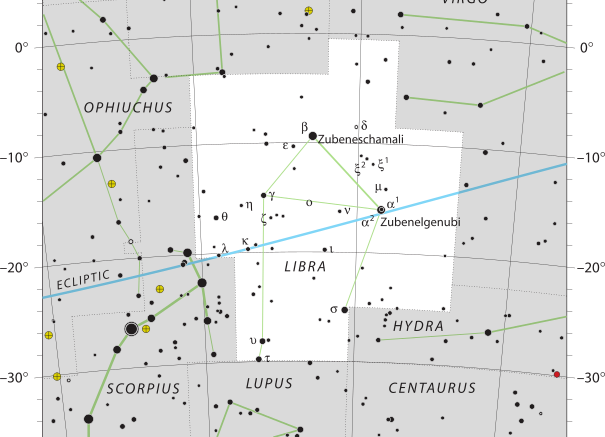The constellation of Libra is located in the southern celestial hemisphere, with its name in Latin meaning weighing scales. The constellation is fairly faint, with no first magnitude stars, with Beta Librae, also known as Zubeneschamali, is the brightest star in the constellation. 3 star systems are known to have planets.
It covering 538.1 square degrees and 1.304% of the night sky, which means it ranks 29th of the 88 constellations in regards to size.
| Applicable Information | |
| Visibility In Pacific Northwest | March to August |
| Best Times To View | June |
| Right Ascension | 15h |
| Declination | −15° |
| Area | 538 square degrees |
| Main Stars | 4, 6 |
| Brightest Object | Zubeneschamali (β Lib) |
| Meteor showers | May Librids |
| Messier objects | 0 |
| Neighboring Constellations | Serpens Caput, Virgo, Hydra, Centaurus, Lupus, Scorpius, Ophiuchus |
History
Libra was known in Babylonian astronomy as MUL Zibanu, which translates to the “scales” or “balance”, or alternatively as the Claws of the Scorpion.
Ancient Greeks saw the constellation as the Scorpion’s Claws, and since then, Libra has been associated with law, fairness and civility.
In ancient Egypt, the 3 brightest stars of Libra formed a constellation that was seen as a boat.
Libra is mentioned by several astronomers including Manetho, Geminus, and Ptolemy.
It was a constellation in ancient Rome, when it began to represent the scales held by Astraea, the goddess of justice.
Stars
There are 83 stars within the constellation that have a minimum apparent magnitude of 6.5.
The brightest stars of Libra form the shape of a quadrangle, with Alpha and Beta Librae representing the scales’ balance beam, while Gamma and Sigma represent the weighing pans.
Located some 50,000 light years from Earth, globular cluster NGC 5897 is a bright a loose cluster.
Make sure to check out other articles on the site, including a brief introduction to constellations, other constellation articles, and more!

Thanks for sharing. I read many of your blog posts, and have to say that your blog is very good.